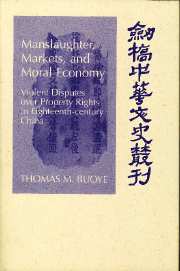 Manslaughter, Markets, and Moral Economy
Manslaughter, Markets, and Moral Economy Book contents
- Frontmatter
- Contents
- List of Maps, Figures, and Tables
- List of Qing Dynasty Emperors' Reign Dates
- List of Weights and Measures
- Acknowledgments
- Introduction
- 1 Economic Change, Social Conflict, and Property Rights
- 2 “Population Increases Daily”: Economic Change during the Eighteenth Century
- 3 “As Before Each Manage Their Own Property”: Boundary and Water-rights Disputes
- 4 “Crafty and Obdurate Tenants”: Redemption, Rent Defaults, and Evictions
- 5 Temporal and Geographic Distributions of Property-rights Disputes in Guangdong
- 6 Violence North, West, and South: Property-rights Disputes in Shandong, Sichuan, and Guangdong
- 7 “You Will Be Rich but Not Benevolent”: Changing Concepts of Legitimacy and Violent Disputes
- 8 Conclusion
- Appendix
- Bibliography
- Index
6 - Violence North, West, and South: Property-rights Disputes in Shandong, Sichuan, and Guangdong
Published online by Cambridge University Press: 28 October 2009
- Frontmatter
- Contents
- List of Maps, Figures, and Tables
- List of Qing Dynasty Emperors' Reign Dates
- List of Weights and Measures
- Acknowledgments
- Introduction
- 1 Economic Change, Social Conflict, and Property Rights
- 2 “Population Increases Daily”: Economic Change during the Eighteenth Century
- 3 “As Before Each Manage Their Own Property”: Boundary and Water-rights Disputes
- 4 “Crafty and Obdurate Tenants”: Redemption, Rent Defaults, and Evictions
- 5 Temporal and Geographic Distributions of Property-rights Disputes in Guangdong
- 6 Violence North, West, and South: Property-rights Disputes in Shandong, Sichuan, and Guangdong
- 7 “You Will Be Rich but Not Benevolent”: Changing Concepts of Legitimacy and Violent Disputes
- 8 Conclusion
- Appendix
- Bibliography
- Index
Summary
The previous chapter examined the temporal and geographic pattern of violent disputes in Guangdong province and their relationship to economic change. How widespread were violent disputes over property rights in the rest of China? With over 56,000 extant reports of homicides related to disputes over land and debts for all of China during the Qianlong reign, it is clear that violent disputes over property rights were not an isolated phenomenon, but, as we shall see, there was significant regional variation. The sheer volume of documents available rules out a “national” study. Instead, I have drawn a second sample of homicide reports for Guangdong, Shandong, and Sichuan. The second sample also shifts the temporal focus to two time periods: 1750–53 and 1779–80. For Guangdong province, there is some overlap between the new sample and the original sample; however 63% of the cases in the second sample (ninety-five disputes) were not part of the original sample. During both periods, grain prices in Guangdong were at or near record highs for the Qianlong reign, with the 1750–53 sample covering the first sharp, upward spike in grain prices during the Qianlong reign, when grain prices were most volatile. During the second period, 1779–80, the market for grain in Guangdong was more integrated. In this sample, as in the large sample discussed earlier, there was a relative decline in the number of homicides related to property-rights disputes in the later part of the Qianlong reign. This approach allows us to compare two distinct economic cycles during the Qianlong reign and to examine the cumulative effects of population growth and commercialization on economic institutions.
- Type
- Chapter
- Information
- Manslaughter, Markets, and Moral EconomyViolent Disputes over Property Rights in Eighteenth-Century China, pp. 153 - 192Publisher: Cambridge University PressPrint publication year: 2000
